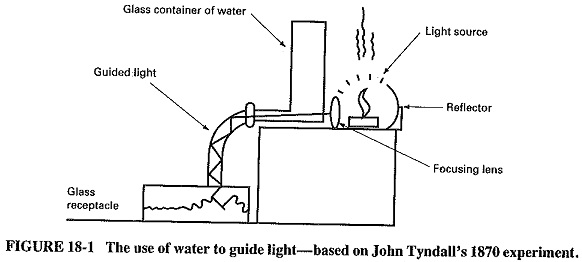Fiber Optics History:
Fiber Optics History – In 1870 John Tyndall, a natural philosopher living in England, demonstrated one of the first guided light systems to the Royal Society. His experiment involved using water as a medium to prove that light rays bend. He filled a container with water and allowed the water to escape through a horizontal orifice at the bottom. The water escaping from the bottom formed a natural curve (parabolic) as it descended to a container located some distance below the first (see Figure 18-1). During the movement of the water from one container to the other, Tyndall directed a beam of light into the orifice through which the water was escaping. The light followed a zigzag path in the water and then followed the curve to the container below.
During the early 1950s researchers experimented with flexible glass rods to examine the inside of the human body. By 1958 Charles Townes and Arthur Schawlow of Bell Laboratories had theorised the use of the laser as an intense light source. In 1960 Theodore Maiman of Hughes Research Laboratory operated the first laser. In 1962 the first semiconductor laser was in its infancy.
Throughout the 1960s and 1970s major advances were made in the quality and efficiency of Fiber Optics History and semiconductor light sources. Today this emerging field of communications competes with its more established wire conductor counterpart. One notable achievement was an experiment carried out by, the U.S. Air Force. In 1973 the Airborne Light Optical Fiber Technology (ALOFT) program replaced 302 cables which weighed 40 kg by a fiber system which weighed only 1.7 kg (1 kg = 2.2046 lb).
By the late 1970s and early 1980s every major telephone communications company was rapidly installing new and more efficient fiber systems.
Why Optical Fibers Used:
Because of rapidly increasing demands for telephone communications throughout the world, multiconductor copper cables have become not only very expensive but also an inefficient way to meet these information requirements. The frequency limitations inherent in the copper conductor system (approximately 1 MHz) make a conducting medium for high-speed communications necessary. The optical fiber, with its low weight and high-frequency characteristics (approximately 40 GHz) and its imperviousness to interference from electromagnetic radiation, has become the choice for all heavy-demand long-line telephone communications systems.
The following examples illustrate and emphasize the reasons for using optical fibers.
- The light weight and noncorrosiveness of the fiber make it very practical for aircraft and automotive applications.
- A single fiber can handle as many voice channels as a 1500-pair cable can.
- The spacing of repeaters from 35 to 80 km for fibers, as opposed to from 1 to 1 1/2 km for wire, is a great advantage.
- Fiber is immune to interference from lightning, cross talk, and electromagnetic radiation.
